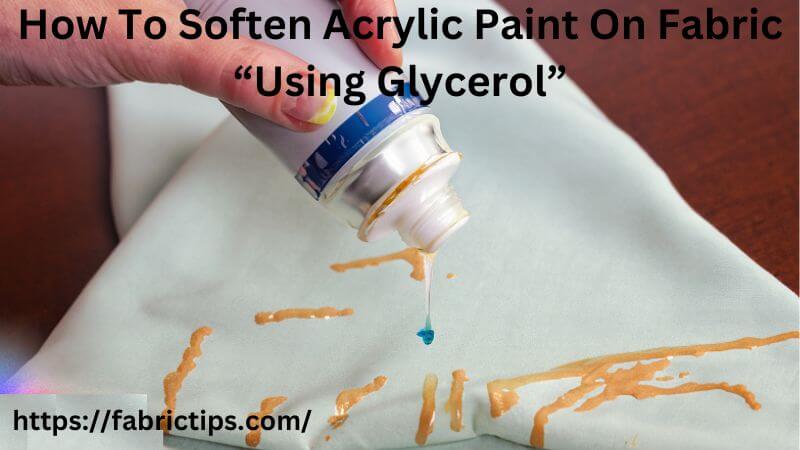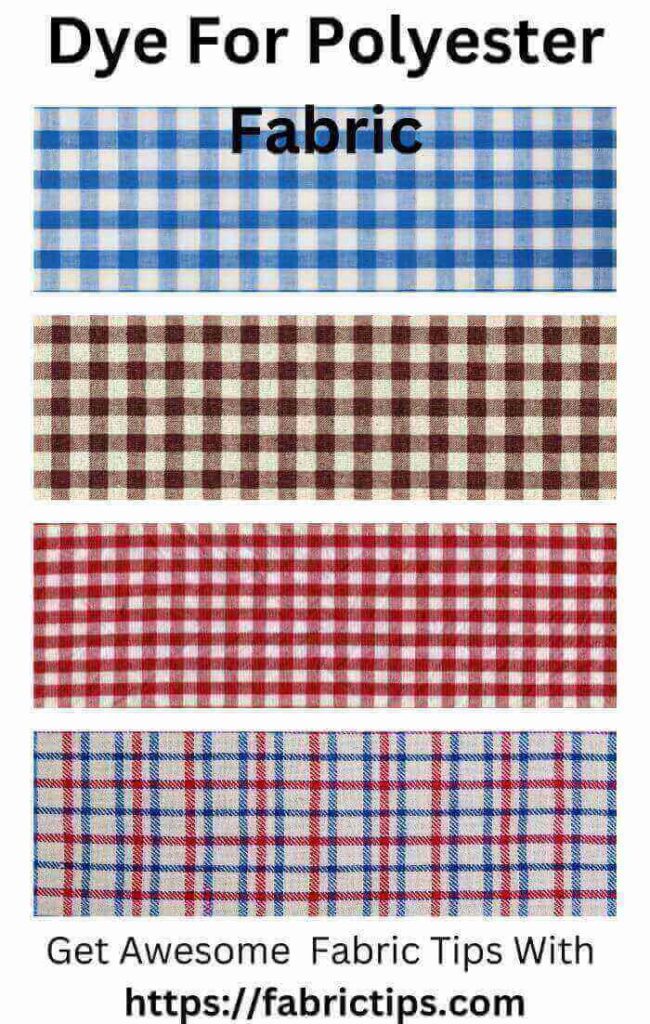Last Updated on December 13, 2025 by Wahid
On weekends we enjoy spending quality time with old clothes, which allows us to use our creative skills and artistic insight. Acrylic paint is perfect when it comes to painting on fabric. Hence, knowing softening acrylic paint on fabric is crucial.
A popular feature of acrylic paint is that it dries instantly and provides the brightest colors. They are also quite affordable & non-toxic; therefore, pets and kids can use them as well. Besides acrylic paint being oil- and wax-free, it can also be applied to any surface. Similarly to other paints, acrylic paint has both pros & cons. Moreover, acrylic paint easily cracks & can ruin your artwork.
Is your old outfit ready to be turned into art this weekend? Acrylic paint can be softened to improve its composition & resist cracking after application. The following tips and tricks will help you how to soften acrylic paint on fabric.
Reason To Soften Acrylic Paint On Fabric

Softening acrylic paint on fabric can be useful in a few situations. For example:
Improved Texture: Softening the paint can give it a more fabric-like texture, which can be desirable for some artistic applications.
Improved Flexibility: Softening the paint can make it more flexible, which can be useful if the fabric will be stretched or moved frequently.
Fading: Softening the paint can help prevent it from cracking or fading over time, which can be particularly important if the fabric will be exposed to sunlight or other environmental factors.
Comfort: Softening the paint can also make the fabric more comfortable to wear, as it will be less stiff and scratchy. This can be important for clothing or other items that will be in contact with the skin.
How To Soften Acrylic Paint On Fabric? Various Method
In case you have worked with acrylic paints before, you know how quickly they dry. Your old sports T-shirt will turn into cardboard if you use acrylic paint without softening it. Due to this, acrylic paint is best diluted with acrylic medium to reduce its thickness. Using an acrylic medium keeps the paint’s texture smooth on the surface. Well, acrylic paint can be softened in several ways, let’s see them in detail below.
How To Soften Acrylic Paint On Fabric “Using Acrylic Medium” (Step-By-Step Guide)

Softening acrylic paint on fabric using acrylic medium is a popular method that can produce excellent results. Here are the steps to follow:
- Make sure the acrylic medium you choose is suitable for the fabric. In most art supply stores, you can find these.
- Make sure you follow the manufacturer’s instructions when mixing acrylic medium with acrylic paint. There will be a different ratio for different types of mediums and for different effects, so make sure you read the label carefully.
- Mix the mixture and brush it on to the fabric’s painted areas. Ensure that it is applied evenly and that the whole painted area is covered.
- Make sure the fabric is completely dry before using it. The process may take a few hours, determined by the paint thickness and the type of medium.
- Once the color has dried, rub it gently in a circular motion with a soft-bristled brush. As a result, the paint will become softer and more flexible.
- As soon as the paint becomes stiff, apply additional layers of acrylic medium & paint mixture.
- After allowing the paint to soften according to your preference, air dry the fabric thoroughly before you use or wash it.
Note: Acrylic medium can alter the color and texture of the paint, so always test a small, inconspicuous area first before attempting to soften the paint on a larger area.
How To Soften Acrylic Paint On Fabric “Using Warm Water” (Step-By-Step Guide)

The easiest and most effective way to soften acrylic paint on fabric is to use warm water. Listed below are the steps you need to take:
- Warm water should be filled in a bowl or sink. It is ideal to have warm water, but not hot water.
- Warm water should be used to soak the fabric. Ensure that all painted areas have been submerged fully.
- After soaking for 10-15 minutes, remove the fabric from the water. Using this method, you can loosen the paint and soften it more easily.
- Wring out the excess moisture by removing the fabric from the water. Ensure the painted surface is not damaged.
- Brush the painted area gently with a soft-bristled brush in a circular motion. Softening the paint will result from this.
- Rinse the fabric in cool water to remove any loosened paint particles.
- If the paint is still too stiff, repeat the process with fresh warm water. Additionally, you can soften the paint by adding fabric softener in the water.
- Once the paint has been softened to your liking, allow the fabric to air dry completely before using or washing it.
Note: Always test a small, inconspicuous area first before attempting to soften the paint on a larger area. Also, be aware that some types of acrylic paint may not respond well to this method and may not soften as desired.
How To Soften Acrylic Paint On Fabric “Using Glycerol” (Step-By-Step Guide)

Softening acrylic paint on fabric using glycerol is a popular method that can produce excellent results. Here are the steps to follow:
- Mix equal parts of glycerol and water in a bowl. Glycerol can be found at most drug stores or online.
- Submerge the painted area of the fabric in the glycerol and water mixture.
- Let the fabric soak for 2-3 hours. This will help to soften the paint and make it more flexible.
- After soaking, remove the fabric from the mixture and gently wring out the excess moisture. Be careful not to damage the painted area.
- Use a soft-bristled brush to gently rub the painted area in a circular motion. This will help to further soften the paint.
- Rinse the fabric in cool water to remove any remaining glycerol residue.
- Allow the fabric to air dry completely before using or washing it.
Note: Glycerol can change the color of the paint, so always test a small, inconspicuous area first before attempting to soften the paint on a larger area. Also, be aware that glycerol can make the fabric slightly sticky, so you may need to wash the fabric again after softening the paint.
Tips For Painting On Fabric With Acrylic Paint – Must Read
Painting on fabric with acrylic paint can be a fun and creative way to customize clothing, accessories, and home decor. Here are some tips to help you achieve the best results:
- Choose the right fabric: Not all fabrics are suitable for acrylic paint. In terms of absorbency and color retention, linen, cotton, and canvas are the best options. Fabrics such as silk or nylon that are too slippery or stretchy should be avoided.
- Wash and dry the fabric before painting: This will remove any sizing or chemicals that might interfere with the paint’s adhesion. Make sure the fabric is completely dry before painting.
- Use a fabric medium: Acrylic paint will become more flexible after being mixed with fabric medium, making it less likely to crack or fade over time. Fabric should be painted with the medium mixed with the paint following the instructions provided by the manufacturer.
- Use a palette: Squeeze the acrylic paint onto a palette or a paper plate to make it easier to mix and apply. Use a separate brush for each color to avoid mixing them unintentionally.
- Use a light hand: Apply the paint in thin layers, building up the color gradually. Too much paint can make the fabric stiff and cause it to crack or peel over time.
- Work quickly: Acrylic paint dries quickly, so work in small sections and blend the colors while they’re still wet.
- Set the paint with heat: When the paint is completely dry, use a dryer or an iron to heat set it. As a result, the paint will become more permanent and set.
- Carefully wash & dry the fabric: After the paint has heated set, run a gentle cycle in cold water and wash the fabric. You should avoid the use of bleach and fabric softener, since they can damage the paint. Hang the fabric to dry or use a low heat setting on the dryer.
Nevertheless, you can use acrylic paint to create beautiful and durable patterns on fabric when you follow these tips.
FAQs
01. How To Set Acrylic Paint On Fabric?
Following these simple steps will allow acrylic paint to set on the fabric:
- Prepare the fabric by washing it first: Take care to wash the fabric thoroughly to remove chemicals and dirt. Avoid using fabric softeners and mild detergents.
- Get the fabric ready for painting: Remove wrinkles and folds from the fabric. To prevent paint from bleeding through the fabric, cover it with a cardboard or plastic sheet.
- Using acrylic paint: Paint the fabric with acrylic paint using a brush or sponge. The paint should be applied evenly and covered the entire surface. The paint must be allowed to completely dry before continuing.
- Heat-setting the paint: This will enhance its durability and make it more water-resistant. To do this, you can iron or tumble dry the painted fabric on a medium heat setting for 30 minutes.
- Fabric wash: After the paint has been heat-set, use mild detergent and a gentle cycle on your washing machine to wash the fabric. Fabric softeners and bleach should be avoided. Use a low-heat setting in the dryer or hang the fabric to dry.
By following these steps, you can set acrylic paint on fabric and create long-lasting designs that won’t fade or wash out easily.
02. Can I Use Vinegar To Turn Acrylic Paint Into Fabric Paint?
Unfortunately “NO.” Because vinegar is acidic, it would be advisable not to use it for turning “acrylic paint” into “fabric paint.” There may be a negative reaction, which can ruin your day. Does acrylic paint have a toxic effect? Don’t worry about your feelings. In addition, it is non-toxic, so your pets and kids can play around it.
03. Can I Mix Fabric Paint With Acrylic Paint?
Adding fabric paint to acrylic paint is good, but it must be mixed in the proper proportions. In a simple 1:2 ratio, fabric paint is substituted for acrylic paint by one part.
04. How To Set Acrylic Paint On Fabric?
The acrylic paint design can be heat set safely on a variety of fabric types using different methods. Here are some methods to consider.
- Use a Clothing Iron
- Let It Run in a Tumble Dryer
- Use a Heat Press
- Try Using a Hairdryer
05. How do you make acrylic paint soft on fabric?
By adding a fabric medium, you will be able to adjust the consistency of your paint. The only way to achieve a soft & stretchy result is by using Liquitex Fabric Medium. Thin your paint with distilled water, but do not dilute it too much.
06. How do you make acrylic paint not crunchy on fabric?
When the paint has completely dried (preferably 24 hours), it needs to be heat set to ensure that it is permanent and washable. Heat setting most fabrics takes between 3-5 minutes on high or medium heat.
Sum Up
You’re done. We discuss everything you wish to know about how to soften acrylic paint on fabric.
Unfortunately, acrylic paint on fabric cannot be softened through traditional methods. If you want to create some glorious artwork, check out the tips & tricks mentioned above to soften acrylic paint on fabric. The Halloween season is just around the corner; so use medium-sized canvases to express your creativity.


